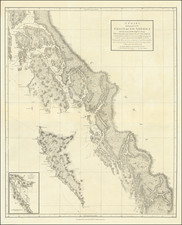A view of New Eddystone Rock in Observatory Inlet, near Behm's Canal in Alaska.
The view includes both First Nation canoes and Engish row boats in the foreground, with New Eddystone Rock in the center of the image and the Alaskan Mountains beyond.
Captain George Vancouver of the British Navy was the first European to observe New Eddystone Rock. In July of 1793, Vancouver arrived at the locale presently known as Observatory Inlet in British Columbia. Here, he anchored his fleet before leading a pair of boats on a coastal survey to the north. He personally steered the yawl from HMS Discovery, while Lieutenant Peter Puget was at the helm of the Discovery's launch.
Venturing northward via the Behm Canal, Vancouver and his team came upon New Eddystone Rock on the morning of Friday, August 9, 1793, where they paused their journey. Vancouver recounts in his dispatch to King George III that during their brief respite for breakfast, they were visited by a friendly group of the indigenous people, around a dozen in number, who arrived in three small canoes. The natives, who were unarmed, landed and greeted the explorers with amicable gestures, graciously accepting the gifts presented to them. Despite not having goods for trade, they warmly invited the explorers to their settlements.
The Eddystone lighthouse, as it was in the era of Vancouver, stood as a beacon similar in its maritime prominence. Although Vancouver declined the invitation from the natives, opting to press on northward, he bestowed upon the island the name of that famed English lighthouse, Eddystone, noting its striking emergence from the sea like the lighthouse that rises from the waters off Plymouth, England.
The view appeared in the Atlas to accompany the official account of Vancouver's expedition, A Voyage of Discovery to the North Pacific Ocean and Round the World, 1791-1795. Published in 1798 to wide public acclaim, Vancouver’s narrative greatly increased the European public’s knowledge about the Pacific Coast.
George Vancouver (1757–1798), a naval officer and explorer, grew up in King’s Lynn, England, the youngest of six children. After entering the Royal Navy in 1771, he served in both the second and third great exploratory voyages of James Cook. During Cook’s second voyage, a three-year quest to find a legendary southern continent, Vancouver received instruction from the astronomer William Wales. During Cook’s third voyage, to the Pacific Northwest, Vancouver was part of the first known group of Europeans to land on the coast of present-day British Columbia.
Vancouver gained valuable navigational, surveying, and mapping experience in the Pacific Northwest during his time with Cook. After returning from Cook’s third voyage in 1780, Vancouver was promoted to lieutenant and spent the following nine years serving on fighting ships, primarily in the Caribbean.
In 1790, Vancouver was chosen to captain the Discovery and charged with a mission to discover and chart the vast areas of the Pacific that were still unknown, in part to locate a Northwest Passage between the Atlantic and Pacific Oceans. This four-year voyage of discovery circumnavigated the globe and eliminated the possibility of an inland Northwest Passage. During many months of surveying, Vancouver produced detailed regional maps of the Northwest Coast, as far north as Alaska. He also established several hundred place-names for physical features in the areas surveyed.
Upon returning to England in 1795, Vancouver’s voyage received little recognition, and he faced personal and political attacks from colleagues and crew members alleging abuse of power. With his health failing, Vancouver spent his remaining years in retirement, revising his journal for publication. His Voyage of Discovery to the North Pacific Ocean, and Round the World was first published in 1798, which was also the year of his death. It contained a multi-volume account of his voyage as well as an atlas of his maps. His exploration and mapmaking activities greatly increased knowledge of the North American coast.










![[ Alaska & Yukon ] Karte zur Abhanđlung über die Geogn. U. Orogr. Beschaffenheit der N.W-Küste Amerikas u. der anliegenden Inseln mit Zugrundelegung der Karten des Hydrogr. Dep. des See-Ministeriums zu St. Petersburg von C. Grewingk 1849](https://storage.googleapis.com/raremaps/img/small/101812.jpg)
![Carte des nouvelles decouvertes dresseee par Phil. Buache… [with] Extrait d'une Carte Japonoise de l'Univers apportee en Europe par Kaempfer . . . [Bay of the West]](https://storage.googleapis.com/raremaps/img/small/84038.jpg)

![[ Pacific Northwest - Northwest Passage ] Limes Occidentis Quivira et Anian. 1597](https://storage.googleapis.com/raremaps/img/small/71207.jpg)
![Asie . . . 1650 [with unusual depiction of the West Coast of North America and the Island of Corey]](https://storage.googleapis.com/raremaps/img/small/102556.jpg)